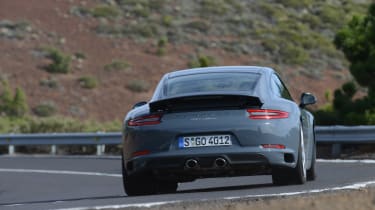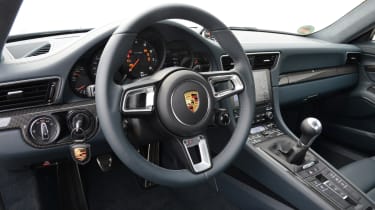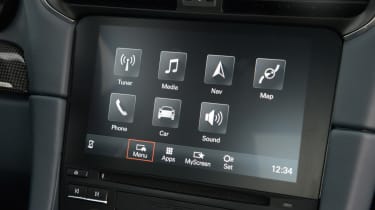Porsche 911 Carrera S 2015 review
Does turbocharging spoil the old-school thrill of the Porsche 911? We test the 991.2 911 facelift models to find out…

The Porsche 911 is now turbocharged, and it’s faster, cleaner and meaner than ever. It’s still a sensational drivers’ car, and on paper it’s better in every way except for a slight increase in price – but then you do get more kit and performance. That last few per cent of visceral involvement from the old naturally aspirated engine has been replaced by startling acceleration and improved efficiency, but we still miss that razor sharp character just a little.
What you really need to know about this new 991.2-generation Porsche 911 is that even the everyday rungs of the 911 ladder – the Carrera and Carrera S – are now turbocharged.
That’s a big step for Porsche, as this is the most significant change to arguably the world’s most iconic sports car in its 52-year history. But diehard fans needn’t worry, as Porsche has captured the spirit of the 911 perfectly with this significant mid-life facelift.
We tested the new £76,412 911 Carrera and £85,857 Carrera S models, and with power up to 365bhp and 414bhp respectively, the S especially is blisteringly fast. That’s a 20bhp increase for both, but the extra urgency comes from the huge slug of turbocharged torque available from just 1,700rpm. There’s 450Nm on tap in the Carrera and 500Nm in the S, which means the 911 no longer thrives on revs like it used to.
Used - available now
• Best sports cars to buy in 2015
Instead, with only 45kg extra to carry over its predecessor, push the throttle and it explodes into the distance as the turbocharged surge of acceleration shocks you in the back. Go for the seven-speed PDK dual-clutch auto with the optional Sport Chrono package and the Carrera S will sprint from 0-62mph in 3.9 seconds, making it the first regular 911 ever to dip under four seconds. That makes it a serious performance car. The Carrera hits 62mph in 4.2 seconds, meaning both cars are 0.2 seconds faster than their predecessors.
On the mountain roads of Tenerife, punching out of tight hairpin corners thanks to the solid wall of drive from low revs, the 911 feels every bit good for those performance claims too. It’s here where the turbos are most noticeable, as they’ve added incredible flexibility, the engine pulling from low revs out of tight corners with no fuss.
You don’t have to work the gearbox quite as hard as a result, but it’s still a delight if you want to. The engine’s rev limiter has been cut to 7,500rpm, and it’s lost a little of the old car’s high rpm fireworks, but it still rasps and barks like a 911 should, overlaid with the faintest hint of a whistle from the turbos. Adding the central-exit, twin-pipe sports exhaust releases a few more welcome decibels and a typical flat-six bassy thrum.
• Which is the best premium car brand?
One of the difficulties with turbocharged engines is lag, but here throttle response is good, with an urgent edge to the way the engine picks up – especially with the extra torque in the S. There’s still a momentary pause in performance if you catch the engine off boost, though.
Sport Chrono cars also get a steering wheel mounted rotary mode switch, just like in the 918 Spyder hypercar – flick this to Sport or Sport Plus and the accelerator is even more sensitive, while the PDK box swaps cogs with a newfound ferocity.
Importantly, with Porsche’s PASM adaptive suspension dampers now standard on the 911, it also tightens up the body control. Porsche claims this makes the 911 not only more comfortable, but a better performance car, too. And despite a 10mm reduction in ride height compared to the previous generation car, the new 911 rides with real composure. It dealt well with Tenerife’s torn tarmac. Stiffen it up and you can feel the extra focus immediately – turn-in has also traditionally been the 911’s weak point, but with wide tracks and fast steering, the nose tucks into corners naturally.
It’s helped by a smaller steering wheel than before, which makes the steering more direct. Porsche has been constantly evolving its electric power assisted steering setup, and aside from its hardcore GT cars, this is the best iteration yet.
It’s not overflowing with feel, but messages from the front wheels are relayed in enough clarity that it gives you a big boost of confidence to push the car harder, leaning on the masses of grip and natural traction from the engine pressing the rear wheels into the ground.
If you go for the Carrera S, those rear wheels can now steer, too, just like on the Turbo and GT3. It means the 911 feels incredibly agile; the back wheels pointing in the opposite direction to the fronts at low speed and turning the same way at higher speed for greater stability.
This hi-tech approach to the chassis continues inside as the seventh generation 911 packs more technology than ever before. As part of Porsche’s brief to make it more usable, the 911 now gets an updated multimedia system with a bigger touchscreen that recognises gestures like a smartphone.
Apple CarPlay is also available while online navigation and real-time traffic info is now standard. It’s a slick piece of kit that addresses one of the older car’s flaws.
Traditionally for Porsche, what it hasn’t changed is the styling. There are a few tweaks to the front and rear bumpers – note the extra vents to help cool the new engine – while the engine cover also now features vertical strakes to help channel air into the motor. Just like the Macan SUV, the rear lights now get a 3D cut-out and the same four-dot running light design as the headlights.
These slight changes mean the car is now more aerodynamically efficient, which helps improve fuel consumption. However, the biggest improvement has come from those turbos. According to Porsche, the PDK-equipped Carrera will return 38.2mpg and 169g/km CO2, while the Carrera S hits highs of 36.7mpg and 174g/km CO2.
So buyers can now go further between fuel stops, while other options such as a nose lifter to avoid scraping the bumper on speed bumps widens the 911’s operating window.
Porsche has delivered an impressive package here, broadening the car’s appeal despite a controversial move in the engine bay. But it means the 911 is better where it matters most. It might have lost a little of its trademark aural signature, but it’s still the sports car to beat.
















